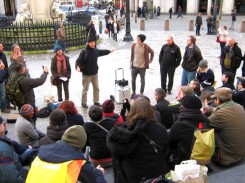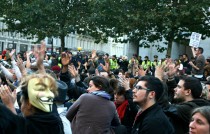General Assembly
The Occupy London General Assembly is our decision making body.
At it’s simplest, a General Assembly (GA) is a gathering of as many occupiers as can make it, who have come together to make collective decisions. General Assemblies were held twice a day during the occupation outside St Paul’s, as there was a lot to decide and organise.
Now, Occupy London’s working groups operate fairly autonomously (with a mandate from the GA) and General Assemblies are called sporadically if a decision about the direction or processes of Occupy London as a whole needs to be made, or if someone wants to issue an ‘Occupy London’ statement on a novel subject.
 A General Assembly can be called if an (as yet unspecified) number of people involved with Occupy London think a discussion needs to happen or a decision needs to be made.
A General Assembly can be called if an (as yet unspecified) number of people involved with Occupy London think a discussion needs to happen or a decision needs to be made.
An agenda (list of items to be discussed, with any proposals to be decided on) is circulated in advance, so that people have time to think about the issues and decisions that are coming up. This agenda is finalised in an open planning meeting directly before the GA. Publicity is generated via OL website, email lists and social media, to ensure as many people as possible get the chance to attend. At least a week’s notice is usually given for a GA.
Everyone’s voice is equal in a GA. Anyone can express an idea or opinion, providing they are respectful of the Occupy London Safer Space Policy and OL processes, which are explained in:
Here’s a pretty inspirational bit of film from the early days of assemblies at Occupy Wall Street, which kicked off in the US just before we erupted onto the cobbles outside the Stock Exchange and St Paul’s in London…
Making a consensus decision about a proposal follows a basic format. An individual shares what is being proposed, why it is being proposed, and how it can be carried out. Those attending the General Assembly will express their opinion through a series of hand gestures (these help large groups to communicate without shouting over each other).
Consensus means that most of those assembled are positively in agreement with a proposal, and no one has a serious valid objection. Where there are objections, amendments to the proposal may be needed before it can go ahead. Sometimes, one or more people object to the proposal so strongly that consensus is not reached and the proposal cannot go ahead.
This process is described in detail in How a General Assembly works.
General Assembly minutes are made available as soon as possible after a GA, often with a link to livestream footage. We also keep a summary of Occupy London’s major agreements and decisions to date.
 Often at a GA, those assembled will split into ‘breakout groups’, usually of between 5 and 20 people, for in depth discussion of particular issues. Each group then feeds back a summary of their discussion for everybody to hear. This enables everyone to contribute and participate, even in very large assemblies.
Often at a GA, those assembled will split into ‘breakout groups’, usually of between 5 and 20 people, for in depth discussion of particular issues. Each group then feeds back a summary of their discussion for everybody to hear. This enables everyone to contribute and participate, even in very large assemblies.
The processes surrounding the General Assembly ahould be democratic, transparent, and accountable. Everybody is welcome to attend and contribute to the activities of the assemblies and GA planning meetings, or simply observe.
If you’re interested to create your own General Assembly, check out the Occupy London’s Toolkit for Occupy Everywhere which was produced for a day of action on December 15th 2011.
Summary of OL agreements and decisions 2011-2014.
Archive of schedule of assemblies and proposals.




